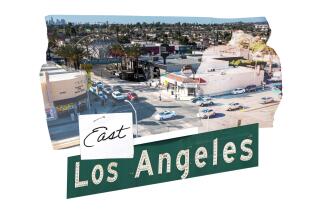That South El Monte has survived is...
- Share via
That South El Monte has survived is a monument to tenacity and community spirit. From being hailed as an All-America City, then later denounced as “the American nightmare,” the image-sensitive city of 22,000 is little different today from its suburban neighbors.
More than 2,000 companies do business here--one for every 11 residents. They are drawn by its “negatives”--no property tax, utility tax or business license fees.
The “City of Achievements,” its official motto, is a mixture of well-kept houses, run-down neighborhoods and light industry wedged between the San Gabriel River and the Rio Hondo. There is no downtown in South El Monte, no central plaza, no shopping mall and no department stores. The combined county assessor’s office-civic center sits next to Kruse Feed & Supply, one of the city’s oldest businesses.
Because no one envisioned anything but farms and industry in South El Monte, the town grew haphazardly, with houses sprouting up between businesses and machine shops. When the boundaries to its sister city, El Monte, were drawn in 1912, the farmlands dotted with sunflower fields to the south were left out.
The postwar boom brought inexpensive housing and, in 1956, the inevitable freeway nearby. Tilled fields gave way to chrome-plating firms and metal fabricators. Residents wanted to preserve the growing wealth for themselves and, fearful that El Monte wanted to annex the community, incorporated in 1958.
During incorporation and as recently as 1994, South El Monte considered changing its image by changing its name, to pull it out from under the confusing shadow of El Monte. Valle Lindo, Potrero Grande, Garvey Park, Whittier Narrows and Santa Anita were all suggested--but each time the idea went no further than talk.
By 1974, the city had bigger concerns. An official survey showed South El Monte with the county’s highest crime and school dropout rates, lowest test scores, fewest doctors and most serious drug abuse and alcohol problems.
Its pride wounded, the city went to work, sponsoring a community health fair, anti-gang and child care programs and other social services. One year later, it was designated an All-America City.
But in 1989, another blow was landed on the city’s ego after a Chicago urbanologist’s study declared that South El Monte represented “the American Nightmare,” with “ramshackle houses, old jalopies, slum schools and dirty air. . . .” City officials responded bitterly that they were being maligned, pointing to the ample middle-class neighborhoods with neat, attractive homes.
Then the recession hit. Many of South El Monte’s small manufacturing plants closed or moved. Garment manufacturers moved in, replacing many well-paying blue-collar jobs with minimum wage positions. When the unemployment rate shot up to 15.5% in 1994, the city teamed with others to create federal enterprise zones.
Today, the “get tough” city is even more serious about selling itself: officials adopted as a new marketing slogan, “South El Monte, We Mean Business.”
(BEGIN TEXT OF INFOBOX / INFOGRAPHIC)
By the Numbers
CITY BUSINESS
Incorporated: July 30, 1958
Square miles: 3
Number of city parks: 1
Number of city employees: 43 fulltime; 47 part time
1996-97 operating budget: $7 million (capital & restricted funds excluded)
ETHNIC MAKEUP
Latino: 85%
White: 10%
Asian: 5%
Black / Other: 1%
PEOPLE
Population: 20,850
Households: 4,754
Average household size: 4
Median age: 25
MONEY AND WORK
Median household income: $27,074
Median household income / L.A. County: $34,965
Median home value: $161,600
Employed workers (16 and older): 9,500
Percentage of women employed: 51%
Percentage of men employed: 78%
Self-employed: 351
Car-poolers: 1,783
FAMILIES
Married couple families with children: 44%
Married couple families with no children: 20%
Other types of families: 24%
Nonfamily households: 12%
RETAIL STORES
Total stores: 158
Total employees: 1,163
Annual sales: $144 million
Source: Claritas Inc. retail figures are for 1995. All other figures are for 1990. Percentages have been rounded to the nearest whole number.
More to Read
Sign up for Essential California
The most important California stories and recommendations in your inbox every morning.
You may occasionally receive promotional content from the Los Angeles Times.













